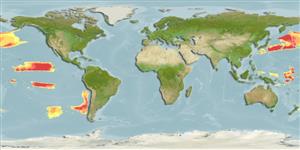>
Stomiiformes (Lightfishes and dragonfishes) >
Gonostomatidae (Bristlemouths)
Etymology: Diplophos: Greek, diploos, = double + Greek, phos = light.
More on author: Günther.
Environment: milieu / climate zone / depth range / distribution range
Écologie
marin bathypélagique. Deep-water
North Pacific.
Taille / Poids / Âge
Maturity: Lm ? range ? - ? cm
Life cycle and mating behavior
Maturité | Reproduction | Frai | Œufs | Fécondité | Larves
Harold, A.S., 1999. Gonostomatidae: bristlemouths. p. 1896-1899. In K.E. Carpenter and V.H. Niem (eds.) FAO species identification guide for fishery purposes. The living marine resources of the Western Central Pacific. Vol. 3. Batoid fishes, chimaeras and bony fishes. Part 1 (Elopidae to Linophrynidae). FAO, Rome. (Ref. 39798)
Statut dans la liste rouge de l'IUCN (Ref. 130435: Version 2024-2)
Menace pour l'homme
Harmless
Utilisations par l'homme
Outils
Articles particuliers
Télécharger en XML
Sources Internet
Estimates based on models
Preferred temperature (Ref.
123201): 1.4 - 1.8, mean 1.6 °C (based on 1712 cells).
Phylogenetic diversity index (Ref.
82804): PD
50 = 0.5312 [Uniqueness, from 0.5 = low to 2.0 = high].
Bayesian length-weight: a=0.00389 (0.00172 - 0.00881), b=2.99 (2.79 - 3.19), in cm total length, based on LWR estimates for this (Sub)family-body shape (Ref.
93245).
Niveau trophique (Ref.
69278): 3.4 ±0.3 se; based on size and trophs of closest relatives
Résilience (Ref.
120179): Milieu, temps minimum de doublement de population : 1,4 à 4,4 années (Preliminary K or Fecundity.).
Fishing Vulnerability (Ref.
59153): Low vulnerability (17 of 100).
